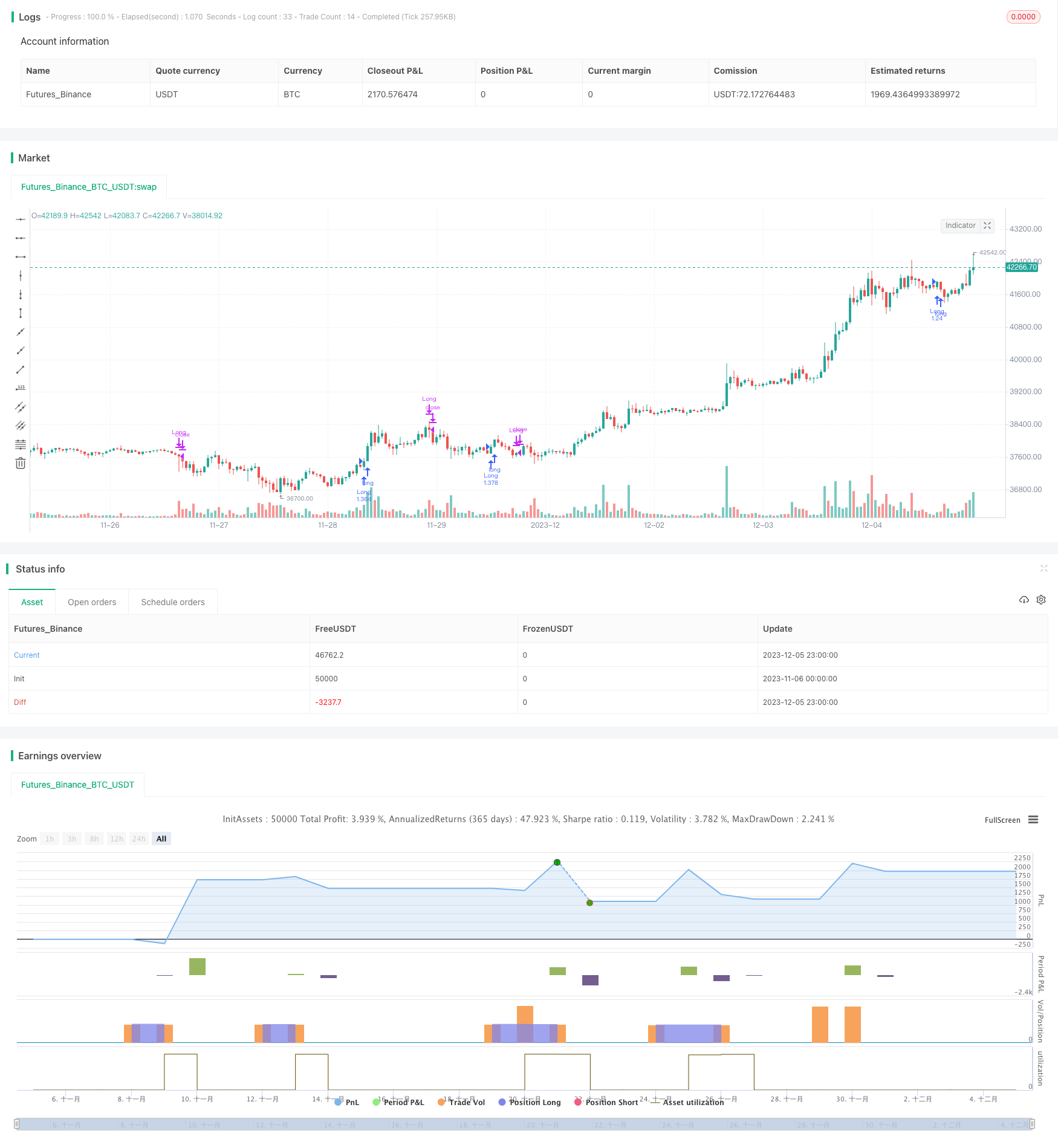
概述
该策略通过判断指数移动均线的方向,确定多空方向。当出现阳线大体吞噬阴线的形态且交易量放大时,进行做多操作。当指数移动均线方向发生转折或出现阴线大体吞噬阳线的形态时,进行平仓操作。
策略原理
使用两条不同参数的指数移动均线,判断市场趋势方向。短期EMA线在长期EMA线之上视为多头市场,反之为空头市场。
当市场处于多头状态时,若出现阳线大体吞噬前一根K线的形态,且交易量要大于前一根K线1.2倍,则产生做多信号。此形态显示多头力量强劲,可以追入做多。
当市场趋势发生转折,即短期EMA下穿长期EMA时,显示多头力量减弱,应平仓。或者当出现阴线大体吞噬阳线的形态时,显示空头力量放量进场,也应主动止损平仓。
优势分析
使用双EMA判断市场结构,能较准确判断多空市场状态。
吞噬形态显示单边力量突然放量进场,可以捕捉较大行情。结合交易量放大 filter,避免被假突破耽误。
有止损机制。由于不设置止损位,使用市场结构转折来止损,可以减少无谓止损带来的滑点损失。
风险分析
双EMA判断市场结构也可能判断错误,从而错过行情或乱入做多。可以适当调整EMA周期参数。
吞噬形态容易被震荡行情误导。可以添加更多filter条件避免误交易。
没有止损位设置可能带来更大亏损。可以试试break even 止损等方法。
优化方向
可以结合更多指标判断多空,例如MACD,能量潮等。
可以酌情添加一定幅度的止损位。
可以根据交易品种特点优化EMA 周期参数。
总结
该策略整体思路清晰易懂,使用指数移动均线判断结构,吞噬形态捕捉突破。优点是判断逻辑简单,交易信号明确。但也存在被套牢的风险。通过进一步优化,可望获得较好回报。
策略源码
/*backtest
start: 2023-11-06 00:00:00
end: 2023-12-06 00:00:00
period: 1h
basePeriod: 15m
exchanges: [{"eid":"Futures_Binance","currency":"BTC_USDT"}]
*/
// @version=5
// # ========================================================================= #
// # | STRATEGY |
// # ========================================================================= #
strategy(
title = "fpemehd Strategy001",
shorttitle = "f_001",
overlay = true,
default_qty_type = strategy.percent_of_equity,
default_qty_value = 100,
initial_capital = 10000000,
currency = currency.USD,
slippage = 0,
commission_type = strategy.commission.cash_per_order,
commission_value = 0.01,
process_orders_on_close = true)
// # ========================================================================= #
// # | STRATEGY |
// # ========================================================================= #
// Inputs
I_start_date = input (defval = timestamp("20 Jan 1990 00:00 +0900"))
I_finish_date = input(defval = timestamp("20 Dec 2030 00:00 +0900"))
I_short_ema = input.int(defval = 15 , title = "Short EMA", minval = 1 , maxval = 300 , step = 1)
I_long_ema = input.int(defval = 30 , title = "Long EMA", minval = 1 , maxval = 300 , step = 1)
I_body = input.float(defval = 1 , title = "Size of Body", minval = 1 , maxval = 5 , step = 0.1)
time_cond = true
// Calculate Engulfing Candles
C_uptrend = false
C_downtrend = false
C_ema_short = ta.ema(source = close, length = I_short_ema)
C_ema_long = ta.ema(source = close, length = I_long_ema)
C_uptrend := close > C_ema_short and C_ema_short > C_ema_long
C_downtrend := close < C_ema_short and C_ema_short < C_ema_long
C_pre_body = math.abs(open[1]-close[1])
C_pre_body_ratio = (math.abs(open[1]-close[1])) / (math.abs(high[1]-low[1])) * 100
C_now_body = math.abs(open-close)
C_now_body_ratio = (math.abs(open-close)) / (math.abs(high-low)) * 100
C_bullish_engulfing = (open[1] > close[1] and open <= close) and (low < low[1] and high > high[1])
C_bearish_engulfing = (open[1] < close[1] and open >= close) and (low < low[1] and high > high[1])
C_avoid_doge = (C_pre_body_ratio > I_body and C_now_body_ratio > I_body) ? true : false
C_volume_filter = volume > volume[1] * 1.2
// Signals
long_signal = C_uptrend and C_bullish_engulfing and C_avoid_doge and C_volume_filter
close_signal = C_downtrend or C_bearish_engulfing
if long_signal and time_cond
strategy.entry(id = "Long", direction = strategy.long)
if close_signal and time_cond
strategy.close(id = "Long")